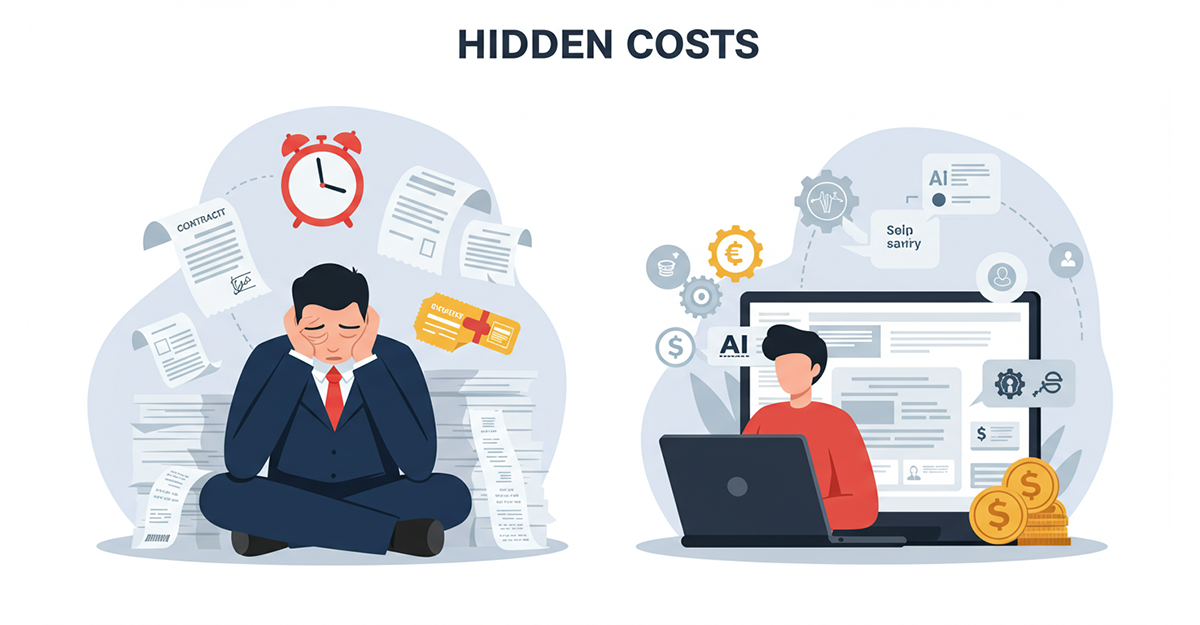In 2025, businesses face rising regulatory demands, increasing contract volumes, and mounting pressure to accelerate deal cycles. Yet many organizations still rely on outdated, manual contract management methods or CLM systems without embedded artificial intelligence. While these approaches may appear cost-effective on the surface, the real contract management cost is hidden in inefficiencies, missed obligations, and revenue leakage.
This article explores the true cost of non-AI contract management in 2025, why traditional methods are failing, and how contract automation reduces both direct and indirect CLM cost.
Contracts as Business Currency
Contracts are no longer just legal formalities. They are the currency of business relationships—defining revenue, obligations, compliance, and risk. However, without modern systems, contracts become bottlenecks:
- Sales teams lose momentum in long approval cycles.
- Procurement struggles to track vendor obligations.
- Finance faces revenue leakage from missed renewals.
- Legal spends time firefighting instead of advising strategically.
While some organizations invest in CLM tools, many still treat contracts as static PDFs or rely on manual contract management with spreadsheets and emails. This approach may seem cheaper, but the hidden costs are staggering.
The Direct Costs of Manual Contract Management
1. Labor Costs
Manual review and approval processes demand significant staff time. Legal teams must redline contracts clause by clause, while sales and procurement staff wait idle. According to industry studies, organizations spend up to 40% more staff hours on contracting without automation.
2. Outside Counsel Fees
Every additional manual review adds external legal expenses. Without AI-driven risk detection, companies often outsource tasks that could be automated, inflating CLM cost unnecessarily.
3. Administrative Overhead
Managing contracts via email chains, PDFs, and spreadsheets requires coordination across multiple departments. The lack of centralization drives duplication of effort and human error.
The Hidden Indirect Costs
Beyond obvious expenses, non-AI CLM creates hidden contract management costs that are even more damaging.
- Revenue Leakage – Missed renewal dates, untracked obligations, and overlooked pricing escalators cause millions in lost revenue annually.
- Compliance Penalties – Regulatory non-compliance due to overlooked clauses can lead to fines, lawsuits, and reputational damage.
- Slower Time-to-Revenue – Deals delayed by weeks mean lost opportunities, particularly in fast-moving industries.
- Risk Exposure – Without intelligent clause analysis, organizations unknowingly accept high-risk terms.
- Employee Burnout – Teams overwhelmed with repetitive tasks face low morale and higher turnover.
These indirect costs often outweigh direct savings from avoiding AI adoption.
The Opportunity Cost of Staying Manual
In 2025, speed is everything. Competitors using contract automation can finalize deals in days, while manual-driven organizations take weeks. The cost of delay isn’t just lost time – it’s:
- Missed market opportunities.
- Frustrated customers who choose faster vendors.
- Longer cash cycles, reducing liquidity.
Opportunity cost may be the single largest contract management cost organizations underestimate.
Case Example: Manual vs AI-Driven
Imagine two SaaS companies negotiating enterprise deals in 2025.
- Company A (Manual): Uses PDFs, email redlines, and legal review for each clause. Average contract cycle = 21 days. Deals worth millions sit in limbo.
- Company B (AI-Native CLM): Uses contract automation to draft, review, and benchmark clauses instantly. Renewal reminders and compliance tracking are built-in. Average contract cycle = 5 days.
Company B recognizes revenue 4x faster, reduces legal costs by 35%, and gains market advantage – all because they avoided the true CLM cost of staying manual.
Why Non-AI CLM Is Obsolete in 2025
- Contract Volumes Are Exploding – Globalization, remote work, and digital ecosystems mean companies manage 10x more contracts than a decade ago. Manual methods simply don’t scale.
- Regulation Is Complex – From GDPR to ESG reporting, compliance clauses require real-time monitoring. Without AI, organizations risk fines and litigation.
- Stakeholder Expectations Are Higher – Sales, procurement, and finance teams expect seamless workflows, not bottlenecks. Customers demand speed.
In this environment, non-AI systems are not just inefficient – they are competitive liabilities.
The Cost Equation: Manual vs Automated
| Category | Manual Contract Management | AI-Driven Contract Automation |
| Labor Hours | 40–60% more time on reviews | 50%+ reduction via automation |
| Legal Fees | Higher reliance on outside counsel | Reduced with AI-powered first-pass review |
| Compliance Risk | High; penalties likely | Low, real-time clause monitoring |
| Revenue Recognition | Delayed by weeks | Accelerated by faster cycles |
| Employee Productivity | Burnout from repetitive tasks | Focus on strategic, high-value work |
The math is clear: the CLM cost of staying manual far exceeds the investment in AI-native platforms.
How Contract Automation Cuts Costs
- Automated Drafting
Pre-approved clause libraries and AI-assisted drafting reduce repetitive work and shorten cycles. - Risk Detection
AI flags non-standard terms and compliance gaps instantly, reducing legal exposure. - Renewal Alerts
Automated reminders prevent lost revenue from missed renewals. - Compliance Tracking
AI continuously monitors obligations against changing regulations, reducing fines. - Bulk Analysis
Thousands of contracts can be classified, scored, and processed simultaneously – impossible with manual review.
The Strategic Benefits of AI-Driven CLM
Beyond cost savings, AI-native CLM delivers strategic advantages:
- Faster Revenue Recognition – Deals close 2–5x faster.
- Better Negotiation Outcomes – AI benchmarks clauses against market norms.
- Data-Driven Insights – Executives see contract trends, risks, and opportunities in real time.
- Scalability – Growth doesn’t require proportional increases in staff.
In 2025, contract intelligence is not optional – it’s a competitive weapon.
Conclusion: The True Cost of Inaction
Sticking with manual contract management or non-AI CLM systems in 2025 is far more expensive than adopting automation. The hidden costs – delays, risks, lost revenue, compliance failures – add up quickly. Meanwhile, competitors using contract management AI and contract automation achieve faster deals, lower costs, and better outcomes.
The verdict is clear: the CLM cost of inaction is higher than the investment in AI-native systems. Organizations that fail to modernize will not only lose money – they will lose ground to competitors who process contracts 10x faster.
